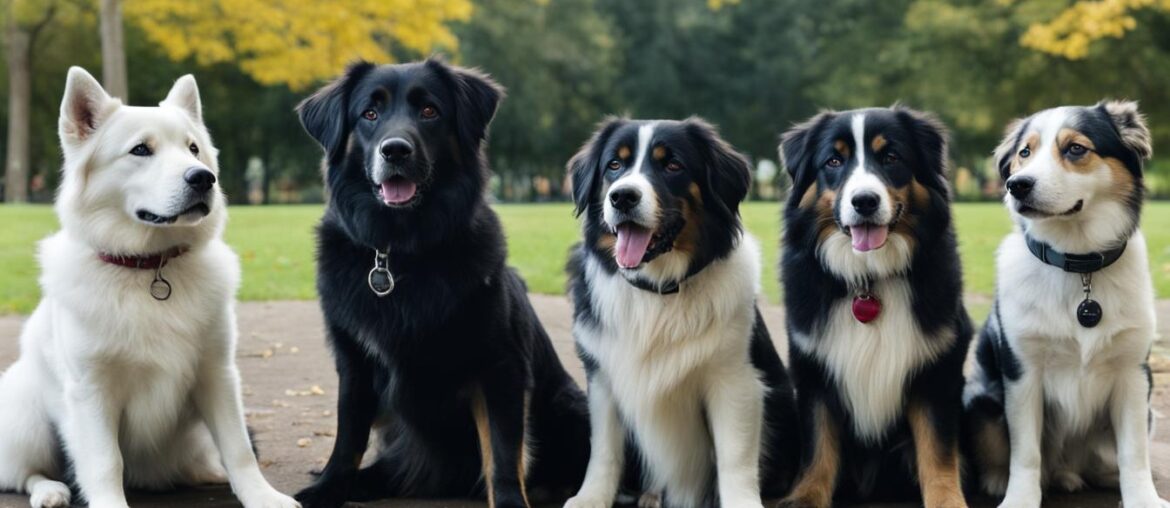Dog owners around the globe often marvel at the undeniable connection they share with their furry friends. Do dogs understand their own name? Before diving deeper into the topic, it’s crucial to shed light on the cognitive abilities of dogs. Studies show that dogs do react to their names, a form of dog name recognition. This recognition is based on positive reinforcement training and dogs’ remarkable listening skills. Understanding a dog’s name is just one facet of their communication abilities, which extends to reading body language and voice tone. Additionally, a dog’s response to its name can be indicative of health issues or discomfort.
Key Takeaways:
- Dogs can recognize and react to their names due to positive reinforcement training.
- Understanding a dog’s name is just one aspect of their communication abilities.
- A dog’s response to its name can provide insights into their overall health and well-being.
- Dogs are capable of responding to multiple names or nicknames.
- The bond between a dog and its owner is strengthened through the dog’s ability to understand its name.
The Cognitive Abilities of Dogs

Dogs possess remarkable cognitive abilities that rival that of a human toddler. Their intelligence and cognitive potential enable them to understand and interact with the world around them in fascinating ways.
One striking aspect of dog cognition is their language comprehension. Dogs can understand up to 250 words, allowing them to decipher basic commands and respond to verbal cues from their human companions. This highlights their impressive capacity for language learning and retention.
But it doesn’t stop there. Dogs are not only capable of understanding words, but they can also perform simple mathematical operations. Through training, dogs can learn to count, differentiate quantities, and respond to basic arithmetic tasks.
Furthermore, dogs possess an innate ability to read human emotions. They can discern subtle changes in facial expressions and interpret vocal intonations, allowing them to understand our moods and respond accordingly. This emotional intelligence contributes to the strong bond that dogs form with their human owners.
One of the most fascinating aspects of dog cognition lies in their highly developed olfactory system. Dogs have an incredible sense of smell that far surpasses that of humans. They can identify and remember scents with astonishing accuracy, including the scent of their owner. This olfactory prowess further enhances their cognitive abilities and contributes to their keen perception of the world.
Recognizing and reacting to their names is another testament to dogs’ cognitive prowess. When a dog responds to its name, it forms a deep bond with its human companion, fostering a relationship built on trust and understanding.
Overall, the cognitive abilities of dogs are truly astounding. Their intelligence, language comprehension, emotional intelligence, and olfactory capabilities all contribute to their exceptional cognitive prowess. These abilities make dogs not only loyal and loving companions but also incredible learners capable of understanding and participating in our human world.
The Science Behind Dog Name Recognition

When it comes to dog name recognition, there’s a fascinating science at play. Dogs react to their names due to positive reinforcement training and the association between their name and positive outcomes. This training encourages them to react when they hear their name, showcasing their remarkable cognitive abilities.
Dogs have an impressive capacity to filter out irrelevant sounds and respond selectively to their own name, even in environments with multiple dogs. This ability highlights their exceptional listening skills and cognitive processing.
Positive reinforcement training plays a crucial role in dog name recognition. The association between their name and positive outcomes creates a strong connection in their minds, reinforcing the importance of their name in their daily interactions with their humans.
Through positive reinforcement, dogs learn to associate their name with treats, praise, and other rewards. This creates a positive association, prompting them to respond eagerly when they hear their name. The use of rewards and positive reinforcement has been proven to be an effective training method and a powerful tool in dog name recognition.
The Power of Association
Association is a fundamental aspect of dog name recognition. Dogs are able to associate the sound of their name with specific positive experiences. This association provides them with a sense of predictability and familiarity, contributing to their overall understanding of their environment.
It’s important to note that dogs’ ability to recognize their name goes beyond simple auditory recognition. They process the association between their name and positive experiences at a deeper level, demonstrating their cognitive capabilities.
| Benefits of Positive Reinforcement Training for Dog Name Recognition | Benefits of Association in Dog Name Recognition |
|---|---|
|
|
Dogs, Their Names, and Health
A dog’s response to its name can be indicative of its overall health. Dogs that exhibit reluctance or discomfort when called may be experiencing underlying health issues such as hip dysplasia or brachycephalic syndrome. Properly observing and interpreting a dog’s reaction to its name can serve as a useful tool in assessing their well-being.
Hip dysplasia is a common condition in dogs, particularly in certain breeds, where the hip joint does not develop properly. This can lead to pain, limping, and difficulty moving. When a dog with hip dysplasia is called by its name, it may exhibit signs of discomfort or hesitation in responding. This could be a result of the pain associated with the condition.
Brachycephalic syndrome is another health issue that can affect certain dog breeds with short, pushed-in faces, such as Bulldogs and Pugs. This syndrome includes various respiratory problems, including narrowed airways, elongated soft palate, and small nostrils. Dogs with brachycephalic syndrome may struggle to breathe properly, especially during exercise or when excited. Their response to their name could be affected by their breathing difficulties.
By paying attention to a dog’s reaction to its name, owners can gain insights into their dog’s comfort level and overall health. If a dog consistently shows signs of discomfort or reluctance when called, it is essential to consult with a veterinarian for a thorough examination. Early detection and proper management of health issues like hip dysplasia or brachycephalic syndrome can greatly improve a dog’s quality of life.
| Health Issue | Description |
|---|---|
| Hip Dysplasia | A condition where the hip joint does not develop properly, leading to pain and mobility issues. |
| Brachycephalic Syndrome | A respiratory condition affecting certain dog breeds with short, pushed-in faces, causing breathing difficulties. |
Key Takeaways:
- A dog’s response to its name can provide insights into its overall health and well-being.
- Reluctance or discomfort when called may indicate underlying health issues such as hip dysplasia or brachycephalic syndrome.
- Paying attention to a dog’s reaction to its name can assist in early detection and proper management of health conditions.
Multiple Names, One Dog

Dogs are highly adaptable creatures that can respond to multiple names or nicknames, showcasing their keen comprehension and linguistic flexibility. In addition to recognizing their given name, dogs have the remarkable ability to understand and react promptly to alternative names. This further highlights their cognitive abilities and their profound understanding of language patterns.
Whether it’s a playful nickname like “Buddy” or a endearing term of affection like “Sweetie”, dogs can effortlessly acknowledge and respond to these alternate names just as readily as they do to their actual given name. This adaptability reinforces the notion that dogs possess a deep understanding of the nuances of human communication.
Having the capacity to respond to multiple names is not only a testament to their mental acuity but also serves as evidence of the strong bond and emotional connection they form with their human companions. Dogs are not merely robotic beings programmed to respond to a single identifier; they possess the remarkable ability to adapt to the diverse ways in which they are addressed.
So, whether you call your furry friend by their given name, a nickname, or a combination of the two, rest assured that your dog’s cognitive abilities enable them to recognize and respond to your chosen identifiers with unwavering loyalty and affection.
| Dog Name | Alternate Names |
|---|---|
| Bailey | Bail, Bails, B-Dog |
| Max | Maximus, Maxie, Maxster |
| Lola | Lo, Lollipop, Lola Bear |
| Riley | Ri-Ri, Riles, Ri-Bear |
Dog’s Name and Bonding

A dog’s ability to understand its own name plays a crucial role in forming a strong bond with its owner. When a dog responds to its name, it establishes a foundation of trust and understanding between the dog and its human companion. Dogs perceive their name as a symbol of love, safety, and comfort.
When dogs hear their name, they recognize that their owner is calling them specifically. This recognition creates a sense of belonging and reinforces the bond between the dog and its owner. Dogs rely on trust and understanding to feel secure in their relationship with their human companions.
Through the dog’s name, the owner can communicate affection, commands, and reassurance. The trust and understanding that develop from this communication enhance the overall bond between the dog and its owner.
“A dog’s name is more than just a word; it’s a connection of hearts.”
Establishing effective dog communication involves more than just the name. Dogs also rely on body language, voice tone, and facial expressions to understand their owner’s intentions and emotions. The combination of these elements creates a robust language through which dogs perceive and respond to the world around them.
Benefits of Dog Bonding Through Name Recognition
The bond formed through a dog’s name recognition has several benefits:
- Increased trust and loyalty
- Enhanced communication and understanding
- Improved obedience and responsiveness
- Heightened sense of security and comfort
By acknowledging their name and responding to it, dogs demonstrate their willingness to build a strong and enduring connection with their owners. This bond nurtures a harmonious relationship based on mutual trust, respect, and affection.
| Benefits of Dog Bonding | Explanation |
|---|---|
| Increased trust and loyalty | A dog that recognizes and responds to its name demonstrates trust in its owner and expresses loyalty. |
| Enhanced communication and understanding | Understanding a dog’s name establishes a common language between the dog and its owner, facilitating effective communication. |
| Improved obedience and responsiveness | A strong bond formed through name recognition fosters obedience and responsiveness to commands, making training easier. |
| Heightened sense of security and comfort | Dogs feel safe and secure when they recognize their name, leading to a higher level of comfort and contentment. |
Dog Communication: Beyond Names

While dogs are skilled at recognizing their names, their communication extends beyond this. They excel at reading body language, voice tone, and facial expressions. Dogs have an innate ability to pick up on subtle cues from their owners, allowing them to anticipate situations and understand their human’s intentions.
Reading body language is a crucial aspect of dog communication. Dogs can interpret the position of their owner’s body, the movement of their hands, and even their facial expressions. A slight change in posture or hand gesture can convey a range of emotions, from excitement to caution or even fear. Dogs are incredibly perceptive in picking up on these cues and adjust their own behavior accordingly.
Voice tone is another important component of dog communication. Dogs can differentiate between a calm and soothing tone and a stern or commanding tone. They can sense the emotions behind the words spoken to them. A soft and gentle voice can reassure a dog, while a firm tone can convey authority or command.
Understanding and recognizing these non-verbal forms of communication can greatly enhance the bond between a dog and their owner. It enables effective training, as dogs can respond to commands based on body language and voice tone. It also allows owners to better understand and meet their dog’s needs, ensuring their comfort and well-being.
Comparative Analysis of Dog Communication Signals
| Signal | Meaning |
|---|---|
| Tail wagging | Excitement or happiness |
| Stiff body posture | Tension or anxiety |
| Relaxed ears | Comfort and calmness |
| Show of teeth | Warning or aggression |
| Barking | Alert or alarm |
| Whining | Need for attention or discomfort |
Consistency is Key

In dog training, consistency is the key to success. Whether you’re teaching your dog its name or training it to respond to commands, using consistent language and cues is crucial for effective communication.
Using the same name or command consistently in the same context helps dogs understand and respond appropriately. Dogs are highly attuned to patterns and repetition, so consistent training reinforces their learning and builds their confidence.
For example, if you’re training your dog to sit on command, always use the same word, such as “sit,” and reinforce it with positive reinforcement. Using different words or cues for the same command can confuse your dog and hamper their progress.
Consistency also extends beyond verbal commands. It’s important to be consistent with your body language, tone of voice, and expectations. Dogs are sensitive to subtle cues, so consistency in your actions and reactions helps them understand what is expected of them.
Consistency is not just about training—it’s about building trust and a strong bond with your dog. When your dog knows what to expect from you and can rely on your consistency, it deepens the connection between you.
Consistency is also essential when correcting unwanted behaviors. If you use different responses or methods each time your dog displays inappropriate behavior, it can confuse them and hinder their understanding of what is acceptable.
Remember, dogs thrive in environments where they feel secure and understand their role. Consistency provides a framework for them to navigate their world and confidently respond to commands.
| Benefits of Consistency in Dog Training |
|---|
| 1. Clear Communication |
| Consistency in commands ensures that your dog understands what is expected of them, leading to clear communication between you and your furry companion. |
| 2. Faster Learning |
| By using consistent cues and reinforcement, your dog can learn commands more quickly and effectively. |
| 3. Strengthened Bond |
| Consistency builds trust, reinforces your bond, and deepens the connection between you and your dog. |
| 4. Reduced Confusion |
| Consistency eliminates confusion and mixed signals, allowing your dog to focus on learning and understanding. |
Wrapping Up
The Fi Dog Collar is a cutting-edge smart collar that revolutionizes canine communication. With its comprehensive features, the collar enhances both the owner’s understanding of their dog and the dog’s well-being.
One of the standout features of the Fi Dog Collar is its GPS tracking capability. This allows owners to easily monitor their dog’s location, offering peace of mind and ensuring their pet’s safety. Whether it’s a hike in the wilderness or a stroll in the neighborhood, the collar keeps tabs on the dog’s every move.
In addition to tracking, the Fi Dog Collar provides advanced health monitoring. It keeps a close eye on the dog’s activity levels, providing valuable insights into their overall wellness. This information empowers owners to make informed decisions about their dog’s exercise routines and detect any potential health issues early on.
Furthermore, the Fi Dog Collar is designed with optimal comfort in mind. It is compatible with flea collars, eliminating the need for multiple accessories. This ensures that the dog’s well-being is not compromised while benefiting from the collar’s state-of-the-art technology.
The Fi Dog Collar is more than just a tracking device; it enhances the bond between dogs and their owners. By providing valuable insights into behavior and health, this smart collar strengthens the connection and understanding between humans and their furry companions. Experience the next level of canine communication with the Fi Dog Collar.
FAQ
Do dogs understand their own name?
Studies show that dogs do react to their names, a form of dog name recognition. This recognition is based on positive reinforcement training and dogs’ remarkable listening skills.
What cognitive abilities do dogs possess?
Dogs possess a cognitive prowess similar to a human toddler. They can understand up to 250 words, perform simple mathematical operations, and are skilled at reading human emotions.
How do dogs react to their names?
Dogs react to their names due to positive reinforcement training. The association between their name and positive outcomes encourages them to react when they hear it. Dogs have a remarkable capacity to filter out irrelevant sounds and respond selectively to their own name, even in environments with multiple dogs.
Can a dog’s response to its name indicate health issues?
Yes, a dog’s reluctance or discomfort when called may signal conditions like hip dysplasia or brachycephalic syndrome. Paying attention to a dog’s reaction to its name can serve as a useful barometer for assessing overall health and well-being.
Can dogs respond to multiple names or nicknames?
Yes, dogs can respond to multiple names or nicknames, showcasing their keen comprehension and adaptability.
Why is a dog’s ability to understand its own name important?
A dog’s ability to understand and respond to its name plays a crucial role in forming a strong bond with its owner. Responding to their name establishes a foundation of trust and understanding.
Can dogs communicate beyond their names?
Yes, dogs excel at reading body language, voice tone, and facial expressions. They can anticipate situations based on their owners’ communication cues, such as tone of voice or facial expressions.
Why is consistency important in dog training?
Consistency plays a vital role in teaching a dog its name or training it to respond to commands. Using the same name or command consistently in the same context helps dogs understand and respond appropriately.
What is the Fi Dog Collar?
The Fi Dog Collar is a state-of-the-art, smart collar that enhances canine communication. It offers GPS tracking, health tracking, and compatibility with flea collars, revolutionizing dog ownership by strengthening the bond between dogs and their owners while providing valuable insights into their behavior and health.






